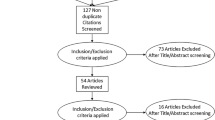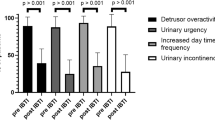Abstract
Purpose
We evaluated the efficacy and safety outcomes of endoscopic intradetrusor botulinum toxin A (BTA) injections for the treatment of children with neuropathic bladder (NB) and non-neuropathic bladder (NNB) with or without detrusor overactivity in a single centre with a retrospective analysis.
Methods
For the period 2006–2015, children who received BTA in our hospital were analysed. They were divided into group 1, those with underlying NB and group 2, those without a clear neuropathic cause of symptoms (NNB). Data are given as percentages or medians (interquartile range).
Results
Over the study period, 52 children (28 boys, 54%) received BTA, 28 in group 1 (54%; 17 (61%) boys) and 24 in group 2 (46%; 11 (46%) boys). Age at first injection was 11.8 (9.5–14.4) years. After initial injection, 40 (77%) reported symptomatic improvement, 17 (43%) becoming dry. There was no significant difference in response to initial injection between groups (p = 0.11). Duration of improvement after first injection was 7 (5.8–14) months. Twenty-five (48%) had further injections, of whom 3 (12%) were initial non-responders. Ongoing improvement was reported in 20 (80%), 11 (44%) of whom were dry. There was no significant difference in overall response to injections between groups (p = 0.11). Of the 11 non-responders, none (0/3) improved after subsequent injection and 3 (27%) subsequently underwent major urological surgery. Of the 40 who responded, 2 (5%) underwent major surgery.
Conclusion
BTA injection produced symptomatic improvement in 77% of our study population, with no significant differences in response between NB and NNB groups. In 95% of those who improved, major urinary tract procedures were avoided during the period studied. None of the initial non-responders improved after subsequent BTA injection. BTA injection is effective and reliable in the management of children with NB and NNB refractory to medical therapy.


Similar content being viewed by others
References
Kask M, Rintala R, Taskinen S (2014) Effect of onabotulinumtoxinA treatment on symptoms and urodynamic findings in pediatric neurogenic bladder. J Pediatr Urol 10:280–283
Dasgupta R, Murphy FL (2009) Botulinum toxin in paediatric urology: a systematic literature review. Pediatr Surg Int 25:19–23
Zeino M, Becker T, Koen M, Berger C, Riccabona M (2012) Long-term follow-up after botulinum toxin A (BTX-A) injection into the detrusor for treatment of neurogenic detrusor hyperactivity in children. Cent Eur J Urol 65:156–161
Uçar M, Akgül AK, Parlak A, Yücel C, Kılıç N, Balkan E (2018) Non-invasive evaluation of botulinum-A toxin treatment efficacy in children with refractory overactive bladder. Int Urol Nephrol 50:1367–1373
Proesmans W (2008) The neurogenic bladder: introducing four contributions. Pediatr Nephrol 23:538–540
Nevéus T, von Gontard A, Hoebeke P, Hjälmås K, Bauer S, Bower W et al (2006) The standardization of terminology of lower urinary tract function in children and adolescents: report from the Standardisation Committee of the International Children’s Continence Society. J Urol 176:314–324
Farhat W, Bägli D, Capolicchio G, O’Reilly S, Merguerian PA, Khoury A et al (2000) The dysfunctional voiding scoring system: quantitative standardization of dysfunctional voiding symptoms in children. J Urol 164:1011–1015
Akbal C, Genc Y, Burgu B, Ozden E, Tekgul S (2005) Dysfunctional voiding and incontinence scoring system: quantitative evaluation of incontinence symptoms in pediatric population. J Urol 173:969–973
Chancellor MB, Elovic E, Esquenazi A, Naumann M, Segal KR, Schiavo G et al (2013) Evidence-based review and assessment of botulinum neurotoxin for the treatment of urologic conditions. Toxicon 67:129–140
Hassouna T, Gleason JM, Lorenzo AJ (2014) Botulinum toxin A’s expanding role in the management of pediatric lower urinary tract dysfunction. Curr Urol Rep 15:426
Larijani FJ, Moghtaderi M, Hajizadeh N, Assadi F (2013) Preventing kidney injury in children with neurogenic bladder dysfunction. Int J Prev Med 4:1359–1364
Schurch B, Stöhrer M, Kramer G, Schmid D, Gaul G, Hauri D (2000) Botulinum-A toxin for treating detrusor hyperreflexia in spinal cord injured patients: a new alternative to anticholinergic drugs? Preliminary results. J Urol 164:692–697
Kajbafzadeh A-M, Moosavi S, Tajik P, Arshadi H, Payabvash S, Salmasi AH et al (2006) Intravesical injection of botulinum toxin type A: management of neuropathic bladder and bowel dysfunction in children with myelomeningocele. Urology 68:1091–1096
Chuang Y-C, Kuo H-C, Chancellor MB (2010) Botulinum toxin for the lower urinary tract. BJU Int 105:1046–1058
Schulte-Baukloh H, Michael T, Schobert J, Stolze T, Knispel HH (2002) Efficacy of botulinum-A toxin in children with detrusor hyperreflexia due to myelomeningocele: preliminary results. Urology 59:325–327
Figueroa V, Romao R, Pippi Salle JL, Koyle MA, Braga LHP, Bägli DJ et al (2014) Single-center experience with botulinum toxin endoscopic detrusor injection for the treatment of congenital neuropathic bladder in children: effect of dose adjustment, multiple injections, and avoidance of reconstructive procedures. J Pediatr Urol 10:368–373
Mangera A, Apostolidis A, Andersson KE, Dasgupta P, Giannantoni A, Roehrborn C et al (2014) An updated systematic review and statistical comparison of standardised mean outcomes for the use of botulinum toxin in the management of lower urinary tract disorders. Eur Urol 65:981–990
Schulte-Baukloh H, Michael T, Stürzebecher B, Knispel HH (2003) Botulinum-A toxin detrusor injection as a novel approach in the treatment of bladder spasticity in children with neurogenic bladder. Eur Urol 44:139–143
Kajbafzadeh A-M, Nikfarjam L, Mahboubi AH, Danat S (2010) Antibody formation following botulinum toxin type A (Dysport) injection in children with intractable bladder hyper-reflexia. Urology 76:233–237
Haferkamp A, Schurch B, Reitz A, Krengel U, Grosse J, Kramer G et al (2004) Lack of ultrastructural detrusor changes following endoscopic injection of botulinum toxin type a in overactive neurogenic bladder. Eur Urol 46:784–791
Gamé X, Mouracade P, Chartier-Kastler E, Viehweger E, Moog R, Amarenco G et al (2009) Botulinum toxin-A (Botox) intradetrusor injections in children with neurogenic detrusor overactivity/neurogenic overactive bladder: a systematic literature review. J Pediatr Urol 5:156–164
Safari S, Jamali S, Habibollahi P, Arshadi H, Nejat F, Kajbafzadeh A-M (2010) Intravesical injections of botulinum toxin type A for management of neuropathic bladder: a comparison of two methods. Urology 76:225–230
Léon P, Jolly C, Binet A, Fiquet C, Vilette C, Lefebvre F et al (2014) Botulinum toxin injections in the management of non-neurogenic overactive bladders in children. J Pediatr Surg 49:1424–1428
Altaweel W, Jednack R, Bilodeau C, Corcos J (2006) Repeated intradetrusor botulinum toxin type A in children with neurogenic bladder due to myelomeningocele. J Urol 175:1102–1105
Author information
Authors and Affiliations
Corresponding authors
Ethics declarations
Conflict of interest
The authors have no conflict of interest to declare. No funding source was involved in this study.
Ethical approval
All procedures performed on human participants were in accordance with the ethical standards of the institutional and national research committee and with the 1964 Declaration of Helsinki and its later amendments or comparable ethical standards.
Informed consent
Informed consent was obtained from the parents of each child prior to all the procedures. All parents were informed about the procedure and off-label status of the BTA therapy.
Additional information
Publisher's Note
Springer Nature remains neutral with regard to jurisdictional claims in published maps and institutional affiliations.
Rights and permissions
About this article
Cite this article
Peeraully, R., Lam, C., Mediratta, N. et al. Intradetrusor injection of botulinum toxin A in children: a 10-year single centre experience. Int Urol Nephrol 51, 1321–1327 (2019). https://doi.org/10.1007/s11255-019-02185-3
Received:
Accepted:
Published:
Issue Date:
DOI: https://doi.org/10.1007/s11255-019-02185-3




